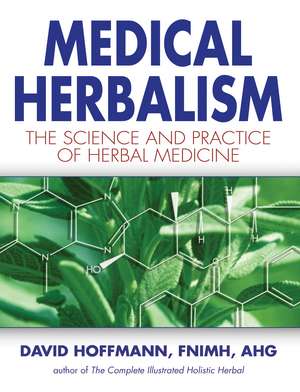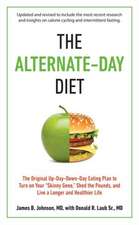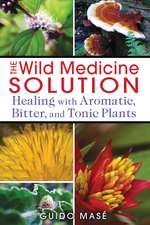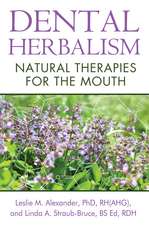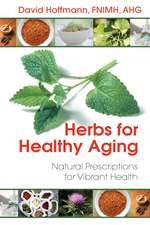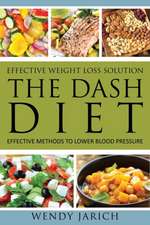Medical Herbalism: The Science and Practice of Herbal Medicine
Autor David Hoffmann FNIMH, AHGen Limba Engleză Hardback – 24 oct 2003
Medical Herbalism contains comprehensive information concerning the identification and use of medicinal plants by chemical structure and physiological effect, the art and science of making herbal medicine, the limitations and potential of viewing herbs chemically, and the challenge to current research paradigms posed by complex plant medicines. It also includes information on toxicology and contraindications, the issues involved in determining dosage and formulation types for an individual, guides to the different measurement systems and conversion tables, and the pros and cons of both industrial and traditional techniques. With additional sections devoted to the principles of green medicine, the history of Western Herbalism, the variety of other medical modalities using medicinal plants, an extensive resource directory, and a discussion of treatments organized by body system, Medical Herbalism is the comprehensive textbook all students and practitioners of clinical herbalism need to develop their healing practices.
Preț: 287.89 lei
Preț vechi: 374.56 lei
-23% Nou
55.09€ • 57.67$ • 45.58£
Carte disponibilă
Livrare economică 21 martie-02 aprilie
Livrare express 04-08 martie pentru 172.62 lei
Specificații
ISBN-10: 0892817496
Pagini: 672
Ilustrații: 487 b&w illustrations
Dimensiuni: 216 x 279 x 41 mm
Greutate: 1.61 kg
Editura: Inner Traditions/Bear & Company
Colecția Healing Arts Press
Notă biografică
David Hoffmann, a Fellow of Britain’s National Institute of Medical Herbalists, has been a clinical phytotherapist for more than twenty-five years. He started his herbal practice in Wales, continuing at the Findhorn community in Scotland, and has been practicing in California since 1986. A long time activist in the environmental and peace movements, he ran for parliament in Britain for the Green party in 1983. He is one of the founding members and a past president of the American Herbalists Guild and is on the advisory boards of the American Botanical Council and HerbalGram. The author of seventeen books, including the highly regarded The Complete Illustrated Holistic Herbal, An Elders’ Herbal, and The Herbal Handbook, Hoffmann teaches phytotherapy throughout the English-speaking world and is currently a faculty member of the California School of Herbal Studies. He is also a visiting faculty member at Bastyr University, the California Institute of Integral Studies, the National College of Phytotherapy, and the Rocky Mountain School of Botanical Studies.
Extras
The Cardiovascular System
The beauty of a spring meadow in bloom, the profound sense of presence in a grove of Redwoods--the heart takes flight and the spirit is healed. This is not the only way in which the magnificent flora with which we share our planet can bring healing to our hearts--it can be physical as well, offering nourishment and healing for our troubled hearts.
Herbs still maintain a central position in orthodox medicines treatment of various heart problems. Plants that contain constituents called cardiac glycosides are used throughout the world for the treatment of heart failure and some arrhythmia’s. In such conditions these herbs increase the strength of heart beat, and normalize the rate of beat. Their real value lies in the increased efficiency not necessitating an increase of oxygen supply to the heart muscle. In heart problems there is often a deficiency in blood supply because of blockage in the coronary arteries. It is not just Foxglove that has such valuable actions. Lily of the Valley shares its therapeutic value but has fewer side effects and lower toxicity. However, herbal remedies nurture the heart in deeper ways as well. Consider the cordial, a warming drink and a word for heart-felt friendliness. The original cordial was a medieval drink based on Borage that warmed the heart and gave the person HEART.
Half the annual mortality in America results from heart and blood-vessel diseases, so any contribution that herbal medicine can make to its treatment is to be welcomed. Modern cardiology can achieve much, and is seemingly miraculous when it comes to acute emergencies, but what of maintaining good health and preventing the development of a pathology? Is there more that we can do for ourselves than simply minimizing risk factors and appropriate exercise? Emphatically yes!
There are profound concerns about toxicity from long term use of prescription medications. Although it is resplendent in ‘wonder drugs,’ the materia medica of modern medical science is sorely lacking in preventive medicines. Tonics are not mentioned in pharmacology texts as the concept is considered illusory. The discarding of gentle toning therapies in favor of intensely active ones can be seen as one of the core problems with orthodox health care. This need not be seen as a clash of approaches which are mutually exclusive. There is a place for gentle toning just as there is a place for the often dramatically successful techniques of cardiology. They can complement and support each other.
The Medical Herbalist recognizes a broad range of relevant herbs for the cardiovascular system. As a group they are known as cardiac remedies. This is a general term for herbs that have an action on the heart. Some of the remedies in this group are powerful cardioactive agents such as Foxglove, while others are gentler and safer cardiac tonics such as Hawthorn and Linden Flowers. Cardioactives owe their effects on the heart to active substances such as cardiac glycosides, thus having the both the strengths and drawbacks of these constituents. Cardiotonics have a beneficial action on the heart and blood vessels but do not contain cardiac glycosides. While not having the dramatic, rapid and often life-saving effects of many cardiological drugs, they have a definite advantage when treating or preventing chronic degenerative conditions. In addition to tonic remedies for the heart there are also tonics for the blood vessels, often rich in constituents called flavones. These remarkable herbs include Hawthorn, Garlic, Linden and Ginkgo.
There are, of course, some limitations to the use of herbs in treating the heart. The most crucial one today is not a herbal limitation but a human. The problem involves self diagnosis, a very hazardous pastime. In the hands of a competent clinical herbalist medicinal plants offer a great deal in the treatment of cardiovascular conditions, but for the non-professional, self selection of herbs or self-diagnosis should never replace competent diagnosis or a substitute for prescription medicines.
HYPERTENSION
A number of herbs have a reputation as being specific for hypertension, usually working because of their impact on one or other of the processes involved in the conditions development. The hypotensives fit this description. The most important plant remedy within western medicine is Hawthorn, probably followed by Linden. European mistletoe (Viscum alba) and Oliveleaves (Olea europaea) are other well known plants thought of as specifics. However the multifactorial etiology of hypertension limit the value of the concept of a specific in its treatment. Orthodox medicine has used Indian Snake root (Rauwolfia serpentina) as a treatment for hypertension, but there are problematic side affects.
One Possible Prescription for Hypertension
Crataegus spp. 2 parts
Tilia platyphylos 1 part
Achillea millefolium 1 part
Viburnum opulus 1 part
Valeriana officinalis 1 part
Dosage: up to 5ml of tincture 3 times a day. Allium sativum should be used as a dietary supplement.
Actions supplied by Hypertension Prescription
• Hypotensive (Crataegus spp., Tilia spp., Achillea millefolium, Viburnum opulus, Valeriana officinalis )
• Cardiotonic (Crataegus spp., Tilia spp.)
• Diuretic (Achillea millefolium, Crataegus spp., Tilia spp.)
• Antispasmodic (Tilia spp., Viburnum opulus , Valeriana officinalis )
• Vascular tonic (Crataegus spp., Tilia spp., Achillea millefolium)
• Nervine relaxant (Tilia spp., Viburnum opulus , Valeriana officinalis )
Other plants would come to mind depending upon the individuals specific symptom picture. For example if headaches are part of the picture of the patients hypertension then include Wood Betony (Stachys betonica) as part of the prescription. If there are palpitations associated add Motherwort (Leonurus cardiaca). Stress as a factor would indicate increasing the nervine content and possibly including an adaptogen.
Cuprins
Introduction
Part One: Introduction to Principles and Practices
1--Herbs, Holism, and Science
Science and Phytotherapy
Pharmacognosy and Ways to Assess Herb Quality
The Conservation of Medicinal Plants
2--Classification of Medicinal Plants
The Linnaean System of Classification
Derivation of Botanical Names
3--An Introduction to Phytochemistry
Primary and Secondary Plant Metabolites
Commonly Used Terms and Concepts
4--Carbohydrates
Monosaccharides
Polysaccharides
Glycoproteins
Glycosides
Gums and Mucilages
5--Lipids
Fatty Acids
Lipids Containing Glycerol
6--Terpenes
Monoterpenes
Iridoids
Sesquiterpenes
Sesquiterpene Lactones
Diterpenoids
Saponins
Triterpenoid Saponins
Cardenolides and Bufadienolides
Phytosterols
Nortriterpenoids
Plant Exudates
Resins
Oleoresins
Balsams
Gum Resins
7--Polyphenols
Simple Phenols and Phenolic Acids
Phenylpropanoids and Cinnamic Acids
Coumarins
Quinones
Xanthones
Stilbenoids
Flavonoids
Flavones and Flavonols
Isoflavonoids
Flavanones
Dihydrochalcones
Biflavonoids
Lignans and Neolignans
Tannins
8--Alkaloids
Pyrrolidine and Piperidine Alkaloids
Tropane Alkaloids
Pyrrolizidine Alkaloids
Purine Alkaloids
Isoquinoline Alkaloids
Indole Alkaloids
Ergot Alkaloids
Carboline Alkaloids
Quinoline Alkaloids
Quinolizidine Alkaloids
Diterpenoid Alkaloids
Steroid Alkaloids
Miscellaneous Alkaloids
9--Pharmacology
Pharmacodynamics
Phytoestrogens
Pharmacokinetics
Immunomodulators
Inflammation and Anti-Inflammatory Agents
Cancer and Plant Constituents
Antiviral Agents
Antioxidants and Free Radical Scavengers
Cardiac Glycosides
Nonsteroidal Cardioactive Plant Constituents
Cholesterol and Lipid-Lowering Activity
Hypertension and Hypotensive Agents
Platelet Function and Cardiovascular
Herbs and the Liver
Hypoglycemic Agents
10--Toxicity, Contraindications, and Safety
Evaluating Causality in Adverse Events
Toxicology
Oxalic Acid
Terpenes
Glycosides
Polyphenolics
Alkaloids
Polypeptides
Lectins
Photosensitivity
11--The Formulation and Preparation of Herbal Medicines
Herbal Medicines
Infusions
Decoctions
Tinctures (Tincturae)
Fluid Extracts (Fluid Extracta)
Syrups, Elixirs, and Emulsions (Emulsiones)
Juices (Succi), Linctuses (Lincti), Mucilages and Oxymels
Waters (Aqua)
Capsules, Pills, and Tablets
Lozenges (Trochisci) and Pastilles (Pastilli)
Baths (Balneotherapy)
Douches and Enemas
Ointments and Suppositories
Liniments
Gargles (Gargarisma) and Mouthwashes
Inhalants (Vapors) and Spray Solutions (Nebulae)
Oils
Compresses and Poultices
Incompatibility
Part Two: Treatment Approaches by Body System
12--A Model of Holistic Herbal Medicine
Phytotherapeutic Selection Criteria
Dosage and Formulation Criteria
Outline of Treatment Chapters
13--The Digestive System
Flatulence
Constipation
Laxatives
Diarrhea
Aphthous Ulcers
Periodontal Disease
Esophagitis and Gastroesophageal Reflux
Gastritis
Peptic Ulcers
Hiatus Hernia
Functional Dyspepsia or “Indigestion”
Irritable Bowel Syndrome
Inflammatory Bowel Disease
Ulcerative Colitis
Diverticulitis
Jaundice
Chronic Hepatitis
Viral Hepatitis
Cirrhosis
Cholecystitis
Cholelithiasis
Hemorrhoids
14--The Cardiovascular System
Tonics for the Cardiovascular System
Cholesterol
Hypertension
Arteriosclerosis
Congestive Heart Failure
Angina Pectoris
Peripheral Arterial Occlusive Disease
Varicose Veins
15--The Respiratory System
Coughs
Acute Bronchitis
Chronic Bronchitis
Pertussis
Asthma
Emphysema
The Common Cold
Influenza
Hay Fever
Sinusitis
Laryngitis
Tonsillitis
16--The Nervous System
Managing Stress: An Overview
Depression
Insomnia
Withdrawal from Benzodiazepines
Anorexia Nervosa
Headache
Migraine
Neuritis
Tinnitus
Motion Sickness
Shingles
17--The Urinary System
Frequency
Dysuria
Hematuria
Edema
Cystitis
Urinary Calculus
18--The Reproductive System
Emmenagogues
Amenorrhea
Dysmenorrhea
Premenstrual Syndrome
Menopause
Pregnancy
Herbs to Avoid During Pregnancy
Uterine Fibroids
Endometriosis
Fibrocystic Breast Disease
Benign Prostatic Hypertrophy
19--The Musculoskeletal System
External Applications for Musculoskeletal Problems
Myalgia
Osteoarthritis
Rheumatoid Arthritis
Osteoporosis
Gout
Bursitis and Tendinitis
Restless Leg Syndrome
20--The Skin
Herbs for Topical Application
Eczema and Dermatitis
Psoriasis
Acne
21--The Immune System
General Support Protocols
Detoxification
Postoperative Recovery
General Guidelines for Treating Infection
Vaginitis
Prostatitis
Boils
Fungal Skin Infection
Cancer
22--The Endocrine System
Hypothyroidism
Hyperthyroidism
Diabetes Mellitus
The Adrenal Glands
23--Phytotherapy and the Elderly
Toning and Nurturing Health in Elders
Prevention and Treatment of Disease in Elders
24--Phytotherapy and Children
Measles
Mumps
Colic
Constipation
Diarrhea
Indigestion
Nausea
Otitis Media
Attention Deficit Disorder
Diaper Rash
Cradle Cap
Impetigo
25--Herbal Actions
Adaptogen
Alterative
Anticatarrhal
Anti-Inflammatory
Antimicrobial
Antirheumatic
Antispasmodic
Astringent
Bitter
Cardiac Remedies
Carminative
Cholagogue
Demulcent
Diuretic
Emmenagogue
Expectorant
Hepatic
Hypnotic
Hypotensive
Nervine
Stimulant
26--Materia Medica
Appendices
1--Glossary
2--Selected Examples of Binomial Meanings
3--Herbs by Latin and Common Names
4--Pharmacy Terms
5--Weight and Measure Conversion
6--Herbal Information Sources
7--Taxonomy Hierarchy
Bibliography
Index
Recenzii
“Hoffmann beautifully blends science with his very holistic approach to herbal healing, displaying a true gift for making chemistry and physiology easy to understand. He not only suggests herbs and dietary changes to treat many conditions but explains why they work. Such knowledge aids both practitioner and herb user in understanding how they can choose the most effective and safe herbs. I applaud this as an important book for herbalism in the modern world.”
“I consider David Hoffmann one of the most original and brilliant herbalists of our time, who dwells 'on the cutting edge' of thought and is often paving the way for others. The author of one of our finest herbal classics, The Complete Illustrated Holistic Herbal, David’s ambitious undertaking of his brilliant new book provides us with yet another exceptional textbook on herbs that merges art, science, and conservation into a system of holistic herbalism for the future. This will be a valuable book for practitioners of herbal medicine as well as for other medical professionals.”
"A well-written compendium of herbal medicine that cannot be found elsewhere in a single book."
"Contains comprehensive information concerning the identification and use of medicinal plants both by chemical structure and physiological effect."
"Medical Herbalism is an endeavor that will likely become a staple as an educational tool and indispensable reference for many."
". . . Hoffman displays a true gift for making chemistry and physiology easy to understand."
“David Hoffmann has outdone himself. This text provides a depth of knowledge that is truly needed by the herbalist, the physician, and the pharmacist in order to understand how to use herbal medicine safely and effectively. Also an excellent resource to educate patients about the many herbal remedies possible.”
“Medical Herbalism provides a clinically oriented, systematic approach to Western herbal medicine missing from most texts. A great contribution to the herbal literature. ”
"For all students and practitioners of herbalism, this complete handbook details the chemistry of herbs and presents in-depth discussions of specific ailments and treatments."
"For mid-level to advanced herbal students, or for any professional health care practitioner, this book represents an outstanding contribution. Kudos to both author David Hoffman and to Healing Arts Press for giving us this amazing volume."
"This is simply the most comprehensive reference work on holistic herbalism from a clinical perspective in existence. . . . This well-researched, incredibly knowledgeable textbook could be said to usher in a new, critical phase in the development of herbalism."
Descriere
A foundational textbook on the scientific principles of therapeutic herbalism and their application in medicine.
